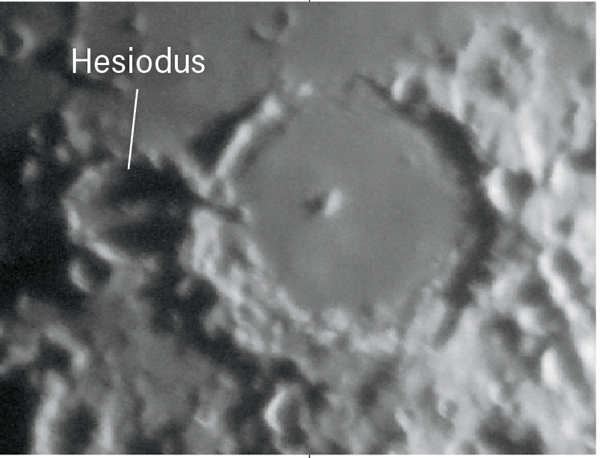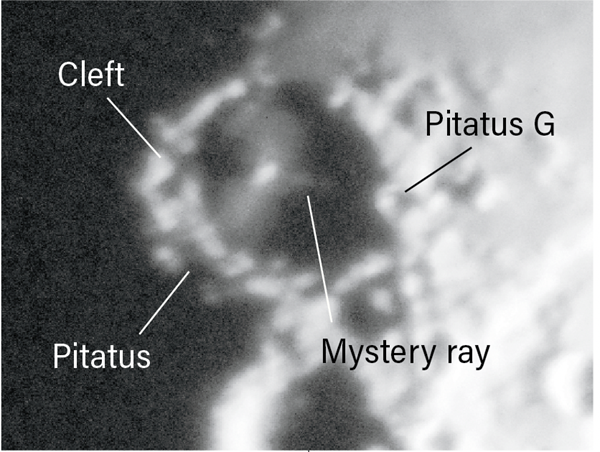Sunrise can be magic — even on the Moon. One prime example lies in Mare Nubium (Sea of Clouds), where the lunar crater Pitatus and its smaller neighbor, Hesiodus, sink into its southern floor like lunar lagoons. And like their earthly counterparts, these lagoons have enchanting elements.
Named after Italian astronomer Pietro Pitati, the crater Pitatus formed some 4 billion years ago. It was later flooded by molten rock seeping through cracks in the crater’s shallow floor.
Even the smallest of telescopes will show a wide gash — a fault line — ripping through the crater’s northwest wall, which is shared with 28-mile-wide (45 km) Hesiodus crater. And at this site, sunrise magic can occur.
Born from light
A near contemporary of Homer, the Greek poet Hesiod, namesake of the crater Hesiodus, believed that the Muses — the nine daughters of Zeus and Mnemosyne, inspirational goddesses of the arts and sciences — filled him with the light of poetry. And in his Theogony (meaning “birth of the gods”), we see how darkness gives birth to light: “Night, pregnant after sweet intercourse with Erebos [the primordial god of darkness], gave birth to … Day.”
Thanks to the gap in the shared crater wall of Pitatus and Hesiodus, when dawn breaks at that location, we can see Hesiod being born from a ray of light, just as night ends and day begins. It is one of the many fascinating sights on the Moon, but you have to catch it at just the right time to receive its full impact.
The Pitatus “gateway” opens about the eighth or ninth day after New Moon, when sunlight slips through the shared cleft — more like a valley — in the crater wall. This creates a spectacular shaft of light across the crater’s shadowed floor. Two weeks later, the reverse happens, with a sunset ray filtering through the cleft to create a narrow light ray slicing eastward across the floor of Pitatus. Philip Koch of Las Vegas popularized the phenomenon, which he first saw in 1988.
Another ray
On the evening of April 20, 2021, the Moon achieved First Quarter. While it was too early to see the Hesiodus ray, I decided to check in on southern Mare Nubium with my 3-inch Tele Vue refractor. I was not disappointed.
While Hesiodus was completely immersed in shade, Pitatus hugged the terminator, offering an eye-catching interplay of light and shadow. It wasn’t long before the view baffled me: Beaming across its flat floor was a narrow ray that broadened slightly toward the crater’s sunlit central peak — splitting the long shadow of Pitatus’s eastern wall in two.
While this ray was a poor cousin to the Hesiodus ray, it warrants attention. Perhaps it is created from some topographical depression in or near the crater Pitatus G, a smaller crater on the rim of Pitatus. The image above was taken through my 3-inch scope, and it does not do the clarity of the feature justice. It looked at first like an illuminated walkway reaching from Pitatus G to the shining monolith that is Pitatus’ central peak. I then noticed lunar ray material north and south of the peak also spreading out across the floor like wings, giving it a birdlike quality.
At the time of my observation, the Moon was 57 percent illuminated and 8.1 days old. The Sun’s colongitude was 14°, meaning the selenographic (lunar) longitude of the morning terminator was –14°. This month, a similar, but not exact, circumstance occurs March 11 at 14:30 UT, when the Moon will be 61.2 percent illuminated and 8.4 days old, with a colongitude of 14°. Will the sunrise ray in Pitatus reappear?
By the way, the sunrise ray in Hesiodus may occur about seven hours and 15 minutes later. As always, send your observations to sjomeara31@gmail.com.












